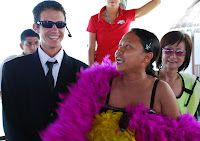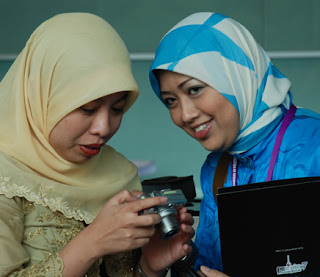I tried to be Green today.
7.24 am - Went bicycling with my youngest daughter. Took her to the padi fields across the road. The morning sun was beautiful, playing softly with the lush green fields of young padi stalks. If you are lucky you can see fighter jets taking off or landing as the narrow gravel road cut right across the end of the RMAF airfield runway. There is no traffic at all on these country roads. You get to enjoy the view of the hills in the distance and even see the top of KOMTAR. The only drawback is the smell of pesticide and weedkillers. The International Rice Research Institute has acknowledged that advances made in double-cropping and higher yield varieties have had negative impacts in terms of the pollution from chemicals used to control pest and weeds and the higher amount of fertilisers used. And did you know that padi fields generate alot of methane, a Green House Gas, when the fields are flooded? But we Asians can't do without rice right? Ah, but urban growth is encroaching into our rice fields. My daughter asked "what's going to happen to our food?"
8.24 am - made it back for breakfast. Asked my daughter if she wants to do it again? "Not tomorrow" she said. She needs to catch her breadth. Makes me feel that "hey, I am doing alright, (stamina-wise)".
9.00 am - straight to my computer to work on the budget for Kampus Sejahtera for 2008. Answer emails. Gave instructions to my RO and other staff to make preparations for the Green Office activities we are organising end of this month. I decided that I won't drive to the office this morning. That's one more green point for me today.
12.10 noon - went to cut up the yam, the meat, the mushroom, garlic, shallot in preparation for dinner. Told my wife I would be late this evening and she would have to take over the cooking.
12.30 noon - took a quick bath. Filled up a tumbler with water to bring along with me. Small foldable umbrella. Put them in a bag and ..
12.51 noon - started walking to the bus stop
12.56 pm - arrived at bus stop at Teluk Air Tawar
12.59 pm - got on the RapidPenang bus heading for the Butterworth Jetty. Fare RM1.50. As I sat down I noticed the sign on the window saying "Please keep the ticket for inspection". Damn, the driver didn't give me a ticket. I debated whether I should go up to claim my ticket or face getting jailed? I decided to be a green activitist - if the ticket inspector were to ask for my ticket I would claim that it is "against my principle to take the ticket because it generates rubbish". What do think? Do you think he will buy it?
1.24 pm arrived at the Jetty, paid RM1.20, waited about 10 minutes for the ferry. Boarded and contemplated getting a bun for lunch. Didn't look too appetising.
1.50 pm (or thereabouts) - got off the ferry. No time to eat my favourite beef noodle soup at the Penang Island side of the Jetty. Too rush to check the signboards so asked a passing RapidPenang staff which bus to take to KOMTAR. He pointed to two buses and said anyone of them. I had contemplated whether I should go and support the poor Penang Yellow Bus. I decided my better bet was RapidPenang. Got one, confirmed that it is going to KOMTAR, paid RM1.00 and the bus left almost immediately. The Yellow Bus was still bleeping for passengers (they wait until they have almost a full load before leaving).
2.10 pm - the bus stopped right in front of an economy rice shop which seemed to be enjoying brisk business.
Oh, the RapidPenang buses seems to stop anywhere when the passengers "ring" the bell. So, I had my economy rice, easy on the rice, and three vegetables - cost RM3.30 plus iced barley (RM0.80). Still pretty cheap huh, lunch in Penang?
2.24 pm - already at the foyer of Auditorium A, KOMTAR. Registered and chatted with some old friends from my days working at the Municipal Council of Penang Island.
2.31 - 5.05 pm - listened to two presentation on greening the buildings organised by PUSPANITA (organisation of lady government servants and wives of senior government officers). Graced by the Chief Minister. Did I get anything out of it? On a scale of 1 to 5, I would say may 2. I think it is an excellent effort but it is an opportunity lost.
5.06 pm - looked at the tea spread out; grabbed a curry puff and headed for the bus stop.
5.20 pm (about) - boarded a mini RapidPenang for the Jetty. Ran to catch the waiting ferry. Sometimes you may have to wait quite a bit for the passenger ferry. I think the Penang Port Authority is more focussed on making money from the vehicular traffic.
6.10 pm (about) - slight drizzle and huge puddles of water at the Butterworth bus terminal. Didn't know which bus is going my way. Asked one bus driver and he said the other one. Some idiot at the back of the bus keeps pressing on the bell to make the bus driver stop quickly (instead of at the bus stops) and the irritated driver obliges. It happened a few times during the journey. Is this the new protocol - stop whenever the passengers presses the bell? As the bus approached Air Tawar and the traffic thinned out, the driver picked up speed. I was surprised because so far they seemed to be very calm and controlled. I was seated right behind the driver and saw the speedometer touch 80 kph. And the speed limit on that stretch? 60 kph. One down for RapidPenang.
6.30 pm - walking back to home sweet home. Got a phone call almost 50 metres from the house from my wife asking whether I needed a lift. Thanks, honey.
9.53 pm - end of my Green Day. Hope you will also have a green day. My next adventure will be to take the public transport to USM.
 It just so happened that I was reading Deepak Chopra's The Book of Secrets which I admit was quite a struggle for me trying to grasp the concepts in the book. It has fascinating views. One of them is that we die everyday (our cells do) ... so that we can live. But another theme I have come across elsewhere which is also discussed by Deepak is the concept of attachment. When we become too attached to certain things, we become materialistic. There also some interesting ideas about time - its all about now, don't focus on the past and the future. Maybe I am not getting all of it but I thought about it and about how we should or could justify demolishing an old building so that we can have something new.
It just so happened that I was reading Deepak Chopra's The Book of Secrets which I admit was quite a struggle for me trying to grasp the concepts in the book. It has fascinating views. One of them is that we die everyday (our cells do) ... so that we can live. But another theme I have come across elsewhere which is also discussed by Deepak is the concept of attachment. When we become too attached to certain things, we become materialistic. There also some interesting ideas about time - its all about now, don't focus on the past and the future. Maybe I am not getting all of it but I thought about it and about how we should or could justify demolishing an old building so that we can have something new.
 Now here's a nicely (well not really either) restored heritage building which used to be occupied by Alumni USM but now covered with huge advertising signs.
Now here's a nicely (well not really either) restored heritage building which used to be occupied by Alumni USM but now covered with huge advertising signs.




















































